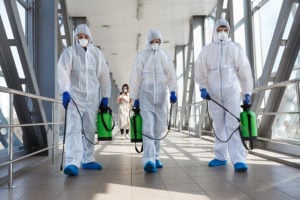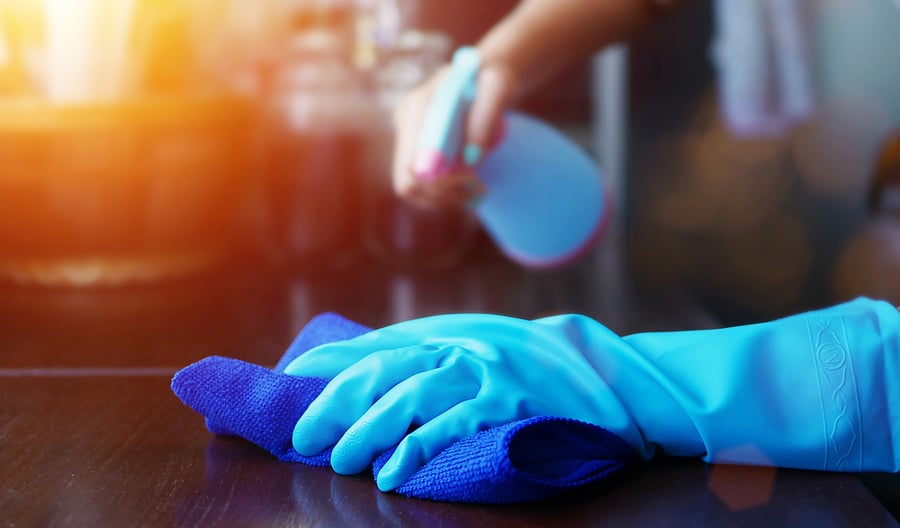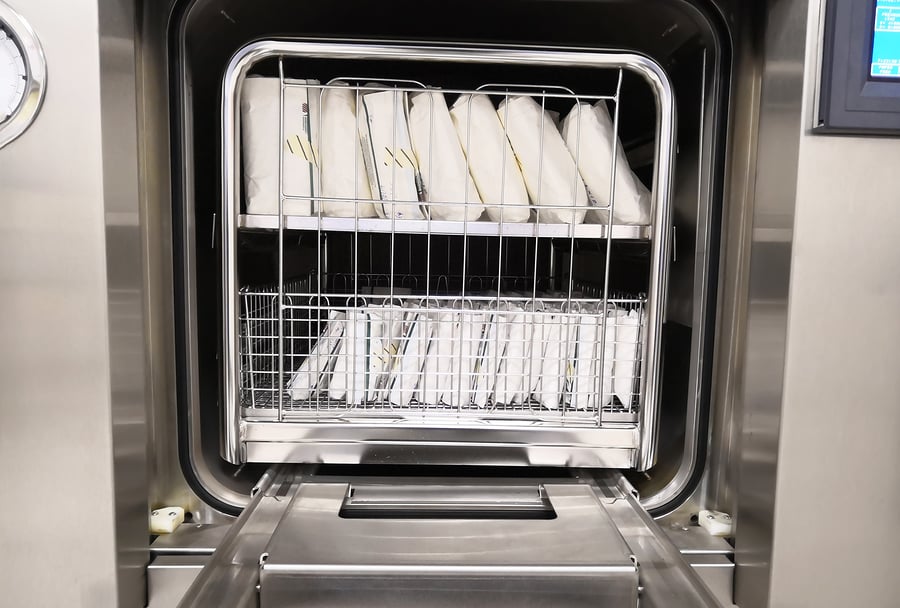Are Disinfectants Registered In Mexico

Nurses and healthcare professionals are expected to follow best practices in infection prevention and control. In all healthcare settings, programs are routinely implemented to prevent and control the spread of infectious diseases.
As a nurse, you regularly hear the words "cleaning, disinfecting, and sterilizing." But what do they exactly mean, and how can you distinguish them from each other? Let's take a deeper dive into these terminologies.
Chain of Infection
The chain of infection is a model that shows the interaction of different factors that lead to the acquisition of an infectious disease. Healthcare professionals use this model as a guide when attending to their patients by "breaking" that chain at its weakest link, which is the mode of transmission to prevent infection to themselves and to other patients.
Weakest Link
The mode of transmission is the means of a bacteria, fungi, virus, or parasite traveling from its source to a susceptible person. It is called the "weakest link" because the transmission of disease can be easily interrupted in many ways.
Interruptions include the appropriate use of personal protective equipment (such as a mask, gloves, and surgical gown), handwashing before and after the patient interaction, disinfection of table surfaces in healthcare institutions, and sterilization of medical and surgical instruments.
Defining Cleaning, Disinfection, and Sterilization
Cleaning is the removal of foreign material, such as soil or food residue, from objects. It's typically done through the use of water with detergents or enzymatic products. It is the same process as what you do with your laundry and dishes.
Disinfection is a process that eliminates many, if not all, disease-causing microorganisms. The only exception is bacterial spores on non-living objects. You can learn more about this method and the chemical disinfectants involved below.
Sterilization is a procedure that breaks up all forms of microbial life. Healthcare facilities perform it through physical or chemical methods, which are discussed next.
Methods of Cleaning, Disinfection, and Sterilization

Cleaning
Cleaning can be done with the use of mechanical units. One of the most commonly used mechanical units are ultrasonic cleaners that utilize high-frequency sound to remove dirt. Studies have shown that using this equipment to clean medical instruments has significantly decreased the number of microorganisms.
Some cleaning solutions, such as a neutral pH detergent, offer proper soil removal and are compatible with most materials. This detergent can be used alone or as a supplement to enzymatic cleaners (chemicals that can attack fats, starches, or proteins) that improves the removal of organic material. However, this requires proper dilution and it's important to check that the soiled material is compatible.
Disinfection
Disinfection can be achieved by the use of chemical disinfectants, heavy metals, UV light emitting machines, and pasteurization. Chemical disinfectants in the form of alcohol, hydrogen peroxide, and chlorine are most commonly encountered even in the household. Each disinfectant is unique and intended for a specific purpose.
Alcohol
Ethyl alcohol, for example, has varying bactericidal and virucidal effects depending on its concentration against different microorganisms. On the other hand, Isopropyl alcohol is only effective in destroying cysts of A. culbertsoni, a parasite that can cause swelling of the brain.
Alcohol is being used to disinfect thermometers, scissors, stethoscopes, and surfaces of medical equipment in healthcare facilities. Like other chemical disinfectants, it cannot be used as a sterilizing medium as it is unable to destroy dormant forms of bacteria.
Unlike cleaning detergents, its composition is not meant for all types of materials. Prolonged and repeated use in disinfecting rubber tubings can cause it to swell and harden.
Chlorine
Chlorine is the most widely used chemical disinfectant in the form of sodium hypochlorite (also known as household bleach). With its wide range of antimicrobial activity, this inexpensive disinfectant is able to remove biofilms created by bacteria from surfaces. Varying concentrations can kill M. tuberculosis, C. difficile, and Candida species in minutes.
Hydrogen Peroxide
Hydrogen Peroxide is an effective disinfectant and is active against bacteria, yeasts, fungi, viruses, and spores. Certain concentrations of Hydrogen Peroxide mixed with a specific acid to lower the pH can be used as a sterilant. It is mainly used on inanimate surfaces and should be stored in dark containers to maintain stability and avoid loss of antimicrobial potency.
Sterilization
Sterilization of equipment destroys all forms of microorganisms on its surface, thus preventing infections associated with that equipment. It's important that the equipment is resistant to sterilization methods and can withstand the process - these are surgical instruments and reusable fabrics.
Steam Sterilization

Steam sterilization is the most commonly used and reliable form of sterilization that utilizes direct steam at a specific temperature, pressure, and duration to kill microorganisms.
A modification of steam sterilization, called Flash sterilization, can be done in a shorter duration but is not recommended for medical implants and is associated with postoperative infections.
Ethylene Oxide Gas Sterilization
Ethylene Oxide can be used alone as a 100% gas or mixed with other gases. It may also utilize peracetic acid as an adjunct.
It is best used in temperature or moisture-sensitive equipment and sterilizes without causing damage. However, this method doesn't apply to equipment with small spaces or lumens.
Hydrogen Peroxide Gas Plasma
This method of sterilization combines the antimicrobial properties of Hydrogen Peroxide and the free radical forming properties of gas plasma. It disrupts the metabolic processes of the microorganism.
Used mainly for instruments that cannot tolerate high temperatures and humidity, this sterilization method is compatible with many materials.
There are many other sterilization methods that make use of different agents, such as gases, radiation, or acidic solutions:
- Peracetic Acid sterilization
- Ionizing radiation
- Dry-Heat sterilizers
- Filtration
- Liquid chemicals
- Performic acid
- Microwave
- Glass bead sterilizers
- Vaporized Hydrogen Peroxide
- Ozone
- Formaldehyde steam
- Gaseous chlorine dioxide
- Vaporized peracetic acid
- Infrared radiation
Breaking the Weakest Link
In the case of any infectious disease, it's critical to maintain the proper knowledge and resources to interrupt the mode of transmission and minimize the risk of a susceptible person acquiring the disease. This can only be accomplished through effective disinfection, sterilization, and cleaning based on established infection control protocols.
RELATED COVID-19 CONTENT ON REGISTEREDNURSING.ORG
- Telehealth to the Rescue During COVID-19 Health Crisis
- They Said There Would be Masks
- The Coronavirus Exposed Flaws in Protecting Nurses: What To Do Next
- List of Freebies for Nurses During the COVID-19 Crisis & Nurses Week 2020
- CDC Estimates of Nurse & Healthcare Worker COVID-19 Cases Are Likely Understated
- Is a KN95 Respirator Safe to Use?
- Are Cloth Masks Protecting Nurses From COVID-19?
- Amid Surging COVID Infections and Increasing Hospital Restrictions, Fearful Pregnant Moms Demand Alternative Birthing Options
- Fight Against Coronavirus: Issues Faced by Nurses in The Philippines
- The Hottest Job During a Pandemic? Travel Nurse
- See all Nursing Articles
- Author
- Recent Posts
![]()
Janine Kelbach, RNC-OB, has extensive experience as an RN in the labor and delivery setting. After becoming a breastfeeding resource nurse and certified CPR instructor, Janine became an assistant manager at a high acuity facility in Ohio, working in postpartum and labor and delivery educating new nurses. In 2012, Janine began writing on healthcare topics for various blogs and websites. Besides writing, Janine enjoys being a mom and spending time with her family and their Great Danes.
![]()
Are Disinfectants Registered In Mexico
Source: https://www.registerednursing.org/articles/cleaning-disinfection-sterilization-what-differences/
Posted by: kellambligh1991.blogspot.com

0 Response to "Are Disinfectants Registered In Mexico"
Post a Comment